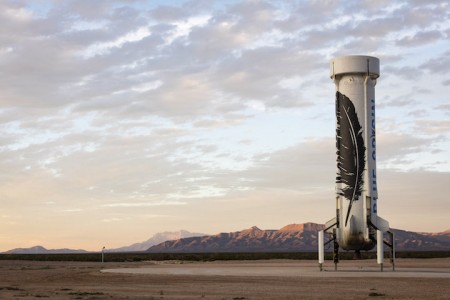November 25, 2015 – Yesterday in Van Horn, Texas, Blue Origin launched and recovered its New Shepard launch vehicle. Unlike the Space X Grasshopper experiments involving a modified Falcon rocket reaching elevations of a mere 744 meters (2,440 feet) before returning to the ground, New Shepard flew to a height of more than 100 kilometers (329,839 feet) before successfully making a controlled soft landing.
The New Shepard is named after Alan Shepard, America’s first astronaut. It is fully reusable and comprises a crew capsule and rocket booster. The engine runs on liquid hydrogen and liquid oxygen and delivers 110,000 pounds of thrust. During flight the uninhabited crew capsule separated and then deployed parachutes upon descent to a soft landing. The booster rocket in descent reignited its engine at an elevation of 1,492 meters (4,896 feet). At point of landing the speed had dropped from 4,593 kilometers (2,854 miles) to a mere 7 kilometers (4.4 miles) per hour.
Blue Origin is Jeff Bezos’ company. He and Elon Musk are in competition to be the first commercial providers of reusable rockets. Upon hearing the news, Musk tweeted his congratulations but described the New Shepard as a “booster” not a reusable rocket. Of course Musk’s company, Space X has been sending Falcon-9 resupply missions to the International Space Station and during several has tried to recover the lower stage of his rocket using a controlled soft landing. To date, none have been successfully recovered.
Bezos hopes to begin flying paying customers into space in a couple of years from now. But is this truly a space race between two commercial rocket companies? Musk, when asked about Blue Origin’s achievement stated that to achieve a sub-orbital flight requires speeds of around Mach 3. The New Shepard actually hit Mach 3.72. Musk went on to state that to achieve orbit and deliver a payload rocket speeds have to be almost 10 times that of the New Shepard maximum velocity.
Bezos, however, sees the New Shepard as much more than a rocket. “It’s kind of a flying robot,” he told CBS News. “It can fly itself up into space, bring itself back down and land so we don’t have to put a pilot at risk during the test program.”
A bigger version of the Blue Shepard rocket engine, designated the BE-3, is being built by Blue Origin for United Launch Alliance and its new Vulcan rocket, the successor to the Atlas and Delta family of boosters. Called the BE-4 it will use liquefied natural gas and liquid oxygen and will produce 550,000 pounds of thrust, five times that of the New Shepard launch vehicle. The BE-4 first stage should be ready to go for full engine tests next year and plans are to put it in service in 2017. It features recovery and reuse capability putting even more competitive pressure on Space X and its reusable rocket program.
Competition will be good for the industry and should drive down the cost of getting to space, one of the biggest inhibitors to expanding our human presence in near-Earth orbit and beyond.










[…] Blue Origin successfully landed its fully reusable New Shepard spacecraft on Monday. [52] Bezos said any rocket booster stage returning to Earth comes back from suborbital velocity, so the conditions experienced by SpaceX’s Falcon 9 and Blue Origin’s New Shepard are comparable. [50] Is this truly a space race between two commercial rocket companies? Musk, when asked about Blue Origin’s achievement stated that to achieve a sub-orbital flight requires speeds of around Mach 3. [59] […]